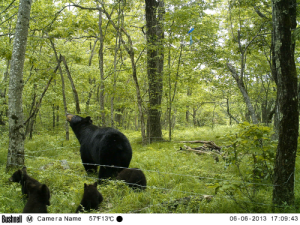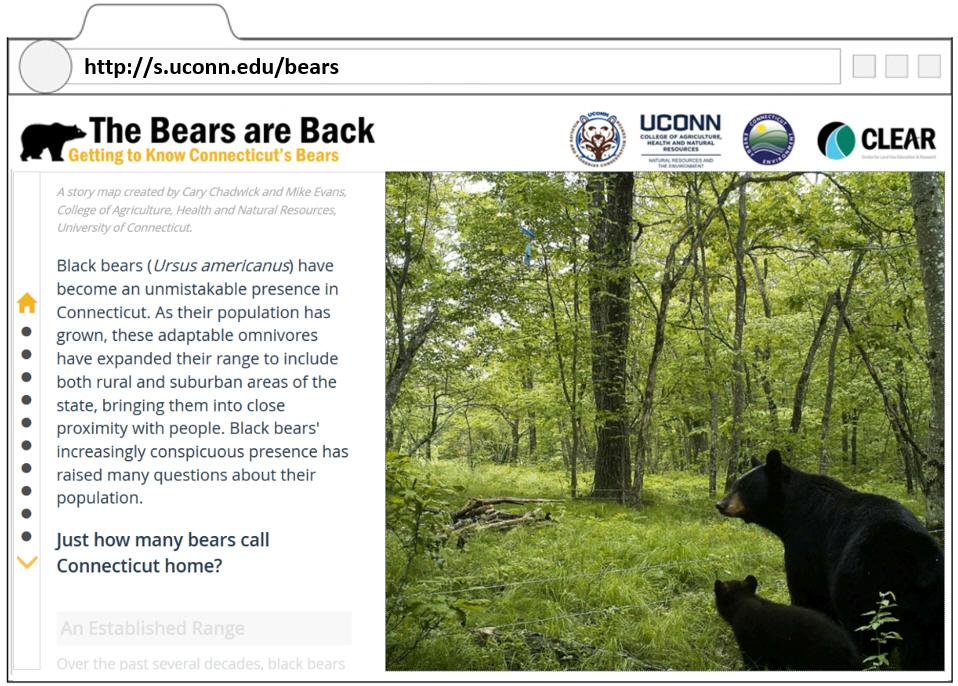By Mike Evans, PhD, University of Connecticut Department of Natural Resources and the Environment
Connecticut is bear country. It may sound strange, but western CT is home to a growing population of American black bears. While bears may at times look out of place in the 4th most densely populated state, black bears living around humans is becoming more and more common not only in Connecticut, but across North America. Even the most densely populated state – New Jersey – is now home to what is likely the densest population of bears. This new reality has instigated new research to understand how bears respond to development, and may require a shift in human perspective to coexist with bears.

The American black bear is a highly adaptable animal – the species’ range stretches from the Arctic Circle into Mexico, and black bears inhabit diverse forested ecosystems ranging from boreal forests, to hardwood swamps, to chaparral shrublands. Typically, the common characteristics of these habitats were inaccessible terrain, and dense understory vegetation. However, over the past twenty to thirty years, the species’ range has been expanding into areas inhabited by people. Black bears are omnivorous, and very flexible in their diets. When encountering development, they may change their eating habits accordingly, utilizing the often abundant resources that humans provide (think trash cans and bird feeders).
Couple this adaptable nature with changing patterns of human development that intersperse housing within forest cover, and you have a recipe for humans and bears to meet. Sightings in western Connecticut have increased steadily over the past decade, spurring new research to understand how bears are responding to different levels of human development. One of the important, and perhaps unsurprising findings, was that places with more intermixing of housing and forest experienced the highest rates of encounters between bears and people.
Yet in Connecticut, bears are by and large not running amok among people (although some individuals seem more prone to this behavior). Black bears are naturally wary. For most of the species’ evolutionary history, black bears coexisted with larger, more aggressive species such as brown bears, and the extinct short-faced bear. Several key findings from research in Connecticut all indicate that, at this point, the population is tolerant of humans, and still retain the species’ innate wariness.
For example, the Connecticut bear population may exist at the highest densities among ‘exurban’ development – places with housing levels somewhere between rural and suburban. This indicates bears are selecting areas with some houses, but still avoid more developed places. Also, when young bears become independent, they were found to move greater distances through more highly developed areas, settling down close to home when moving through forest. Finally, patterns of hourly bear movements in and around development indicate most individuals avoid features like houses and roads.

The finding that Connecticut’s bears have not yet habituated to development makes humans’ role especially crucial. While it is always a good idea to be ‘bear aware’ when in bear country, a wary bear population is an opportunity to shape the future of human-bear dynamics. Recognizing that we are now living with bears is the first step. Practices like removing bird feeders during summer, bear-proofing waste disposal, or installing electric fencing around attractants can not only reduce conflicts now, but may reduce the proliferation of unwanted behaviors as the bear population grows. Connecticut is bear country, and with a little foresight, we can enjoy coexisting with our new neighbors.
This post was written by guest blogger, Dr. Mike Evans. His research is focused on understanding the effects of human density on black bear population ecology in Connecticut.
Interested in learning more about Connecticut’s bears? Check out Mike’s recent CLEAR webinar about his bear research and explore CLEAR’s new story map, “The Bears are Back: Getting to Know Connecticut’s Bears.”